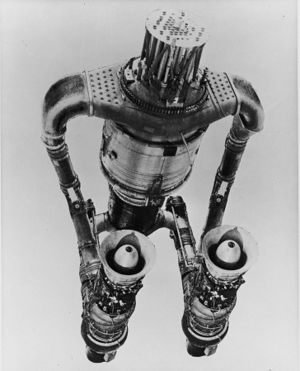Aircraft reactor experiment: Difference between revisions
J.williams (talk | contribs) m (1 revision imported) |
No edit summary |
||
| Line 1: | Line 1: | ||
[[Category:Done | [[Category:Done 2017-07-01]] | ||
[[File:HTRE-3.jpg|300px|thumb|right|Picture of the HTRE-3 aircraft engine <ref>“From Proving the Principle, Chapter 13, pg 122 available: http://webharvest.gov/peth04/20041031010059/http://www.inel.gov/proving-the-principle/chapter_13.pdf [Accessed: 20-Feb-2015].</ref>]] | [[File:HTRE-3.jpg|300px|thumb|right|Picture of the HTRE-3 aircraft engine <ref>“From Proving the Principle, Chapter 13, pg 122 available: http://webharvest.gov/peth04/20041031010059/http://www.inel.gov/proving-the-principle/chapter_13.pdf [Accessed: 20-Feb-2015].</ref>]] | ||
<onlyinclude>The '''Aircraft Reactor Experiment (ARE)''' was an attempt by Oak Ridge National Laboratories (ORNL) that began in the 1940s to power an aircraft by means a [[Molten salt reactor|Molten Salt Reactor]] (MSR) which is a type of [[Nuclear reactor|nuclear reactor]].</onlyinclude> This would have given aircraft a much longer flight range due to the higher energy density of nuclear fuels over fossil fuels. | <onlyinclude>The '''Aircraft Reactor Experiment (ARE)''' was an attempt by Oak Ridge National Laboratories (ORNL) that began in the 1940s to power an aircraft by means a [[Molten salt reactor|Molten Salt Reactor]] (MSR) which is a type of [[Nuclear reactor|nuclear reactor]].</onlyinclude> This would have given aircraft a much longer flight range due to the higher energy density of nuclear fuels over fossil fuels. | ||
A MSR was selected for this project was because they are small reactors and don't need a containment structure. The ARE never saw completion, but the technology was further explored for [[electricity]] production. This resulted in the [[Molten salt reactor experiment|molten salt reactor experiment]] which was the first [[Molten salt reactor|molten salt reactor]] designed for electricity production. One big factor that contributed to the decision to stop ARE research was the invention of intercontinental ballistic missiles, which meant that explosives could be delivered without the use of an aircraft.<ref>D. LeBlanc, “Molten salt reactors: A new beginning for an old idea,” Nucl. Eng. Des., vol. 240, no. 6, pp. 1644–1656, Jun. 2010.</ref><ref>Oak Ridge National Laboratory, “The Development Status of Molten-Salt Breeder Reactors,” p. 416, 1972.</ref> | |||
Revision as of 14:49, 18 August 2017

The Aircraft Reactor Experiment (ARE) was an attempt by Oak Ridge National Laboratories (ORNL) that began in the 1940s to power an aircraft by means a Molten Salt Reactor (MSR) which is a type of nuclear reactor. This would have given aircraft a much longer flight range due to the higher energy density of nuclear fuels over fossil fuels.
A MSR was selected for this project was because they are small reactors and don't need a containment structure. The ARE never saw completion, but the technology was further explored for electricity production. This resulted in the molten salt reactor experiment which was the first molten salt reactor designed for electricity production. One big factor that contributed to the decision to stop ARE research was the invention of intercontinental ballistic missiles, which meant that explosives could be delivered without the use of an aircraft.[2][3]
References
- ↑ “From Proving the Principle, Chapter 13, pg 122 available: http://webharvest.gov/peth04/20041031010059/http://www.inel.gov/proving-the-principle/chapter_13.pdf [Accessed: 20-Feb-2015].
- ↑ D. LeBlanc, “Molten salt reactors: A new beginning for an old idea,” Nucl. Eng. Des., vol. 240, no. 6, pp. 1644–1656, Jun. 2010.
- ↑ Oak Ridge National Laboratory, “The Development Status of Molten-Salt Breeder Reactors,” p. 416, 1972.

